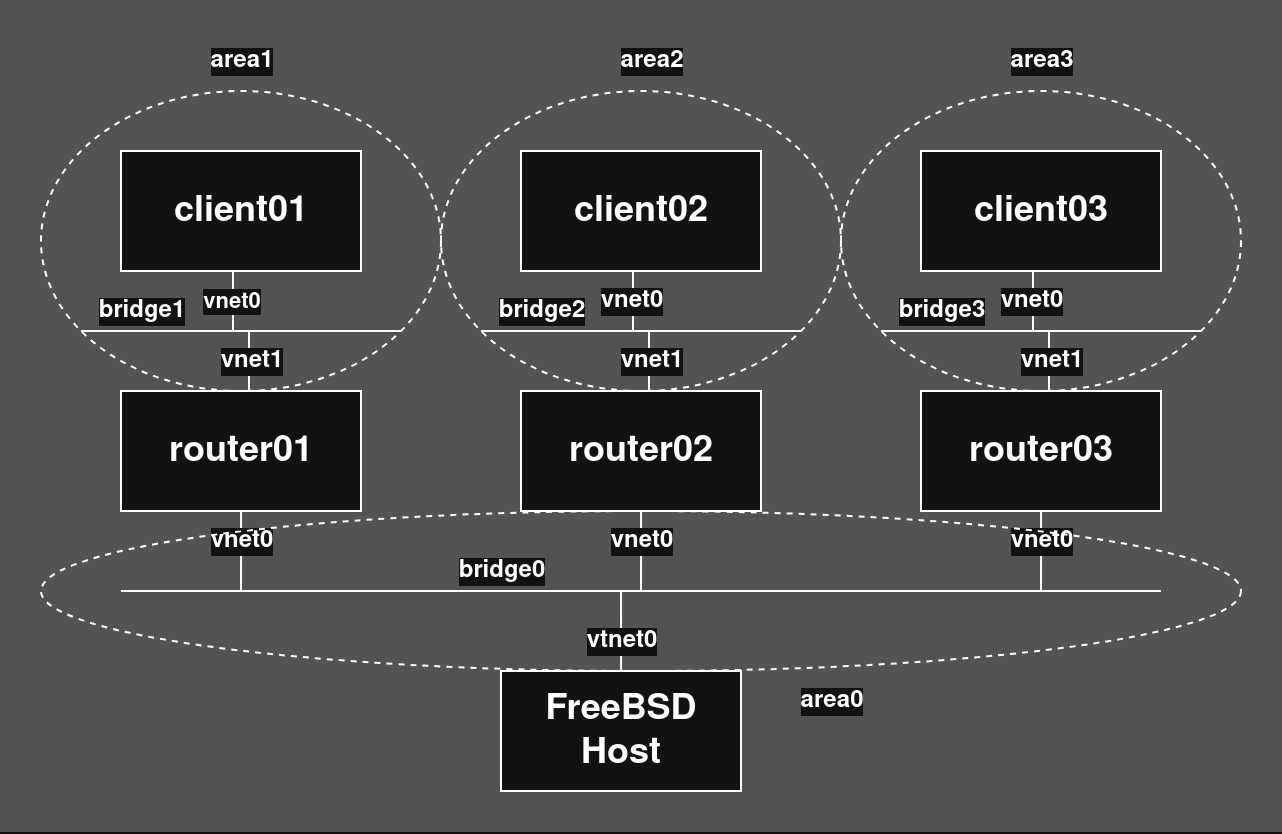Wanted to try a bit of OSPF stuff today, so I created a FreeBSD VM, and three VNET jails ("router01, router02, router03") on bridge0 (vtnet0).
-
Wanted to try a bit of OSPF stuff today, so I created a FreeBSD VM, and three VNET jails ("router01, router02, router03") on bridge0 (vtnet0). Installed Quagga and set up the zebra and ospfd daemons.
Then I created three more VNET jails ("client01, client02, client03" and three bridge interfaces ("bridge1, bridge2, bridge3"), which I used to connect the "client" and "router" jails together.
I've set the "router" jails as the default gateway for the "client" jails and with OSPF doing it's thing, each jail can ping all the IPs of all other jails.
It's pretty amazing to just add another network / interface on on of the "router" jails and immediately be able to reach the new IPs from all other jails, without having to manually add the routes. (I know that dynamic routing is an old concept, but for someone who only works with flat /24 networks, this is really fun.)
Even more amazing is that the entire FreeBSD VM only uses 3.5 GB of storage and 660 MB of RAM, and next to no CPU load. Everything was set up with bastille(8), with only a few commands (ifconfig, sysrc) for creating the bridge interfaces. 😎
-
Wanted to try a bit of OSPF stuff today, so I created a FreeBSD VM, and three VNET jails ("router01, router02, router03") on bridge0 (vtnet0). Installed Quagga and set up the zebra and ospfd daemons.
Then I created three more VNET jails ("client01, client02, client03" and three bridge interfaces ("bridge1, bridge2, bridge3"), which I used to connect the "client" and "router" jails together.
I've set the "router" jails as the default gateway for the "client" jails and with OSPF doing it's thing, each jail can ping all the IPs of all other jails.
It's pretty amazing to just add another network / interface on on of the "router" jails and immediately be able to reach the new IPs from all other jails, without having to manually add the routes. (I know that dynamic routing is an old concept, but for someone who only works with flat /24 networks, this is really fun.)
Even more amazing is that the entire FreeBSD VM only uses 3.5 GB of storage and 660 MB of RAM, and next to no CPU load. Everything was set up with bastille(8), with only a few commands (ifconfig, sysrc) for creating the bridge interfaces. 😎
The OSPF IPv6 daemon is now configured as well, just took me a little longer to realize that I forgot to put "ipv6_gateway_enable=YES" into the router jails /etc/rc.conf 🤪
-
The OSPF IPv6 daemon is now configured as well, just took me a little longer to realize that I forgot to put "ipv6_gateway_enable=YES" into the router jails /etc/rc.conf 🤪
Did a bit more with my OSPF "lab" today:
- Removed defaultrouter in the router jail's rc.conf
- Enabled default route injection on the hosts' ospf process
- Switched all router jails to use area 0 only
- Enabled NAT via pf on the hostAll the jails now have internet access. For IPv6 I don't want to use NAT, so I have to point a v6 route on my firewall to the FreeBSD jail host. 😎
-
 undefined stefano@mastodon.bsd.cafe shared this topic on
undefined stefano@mastodon.bsd.cafe shared this topic on

